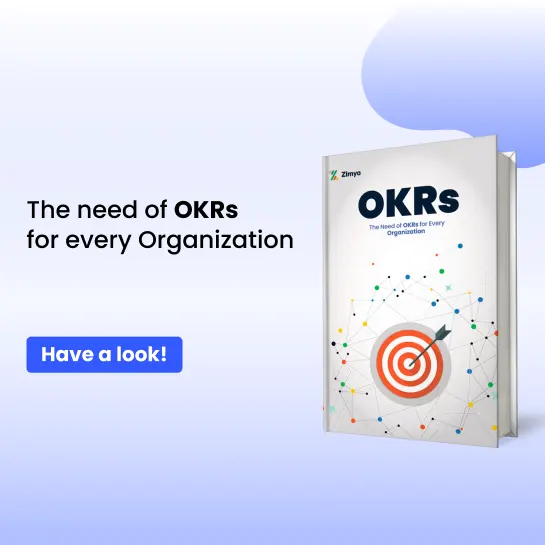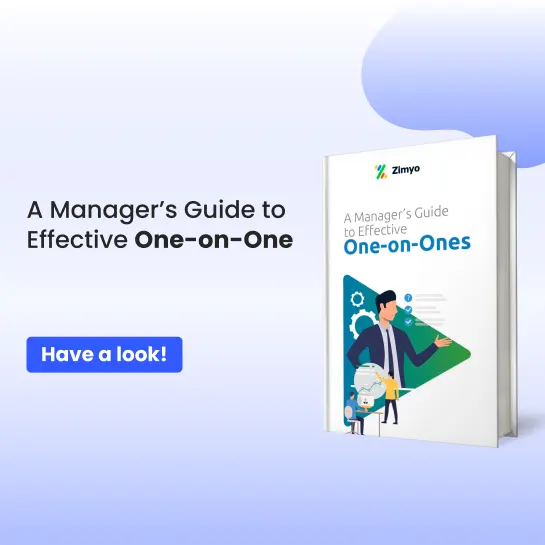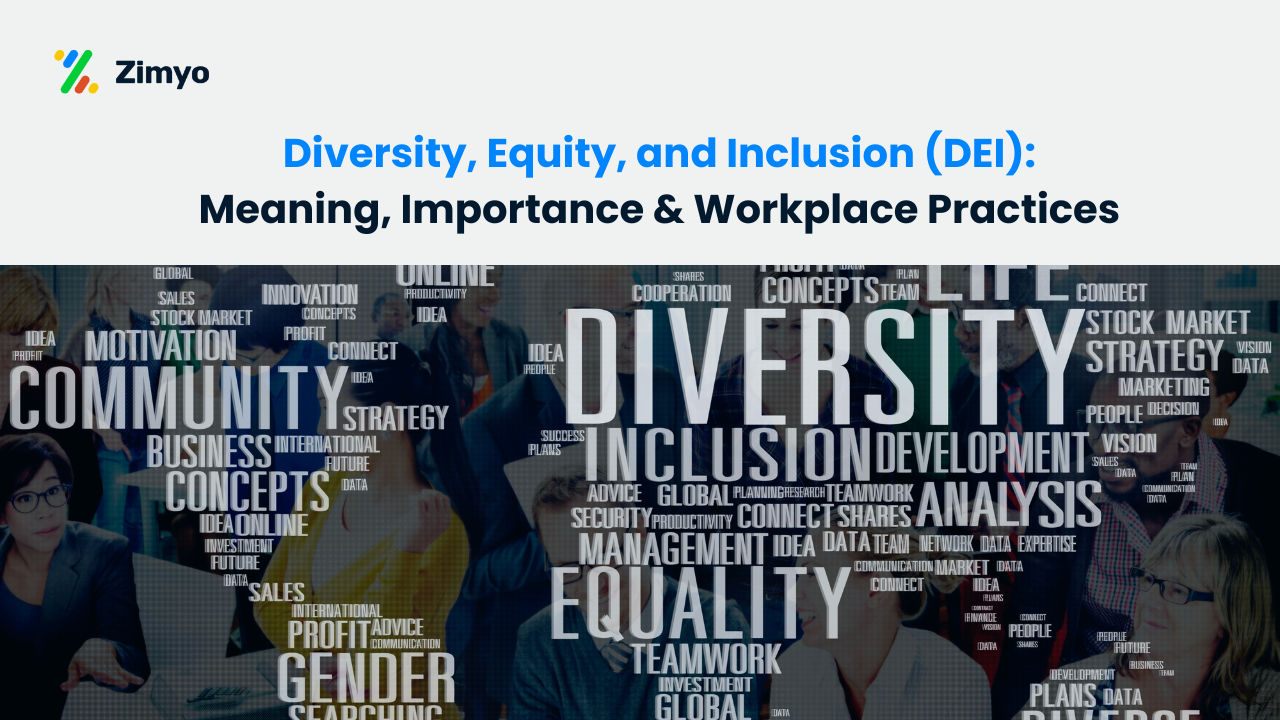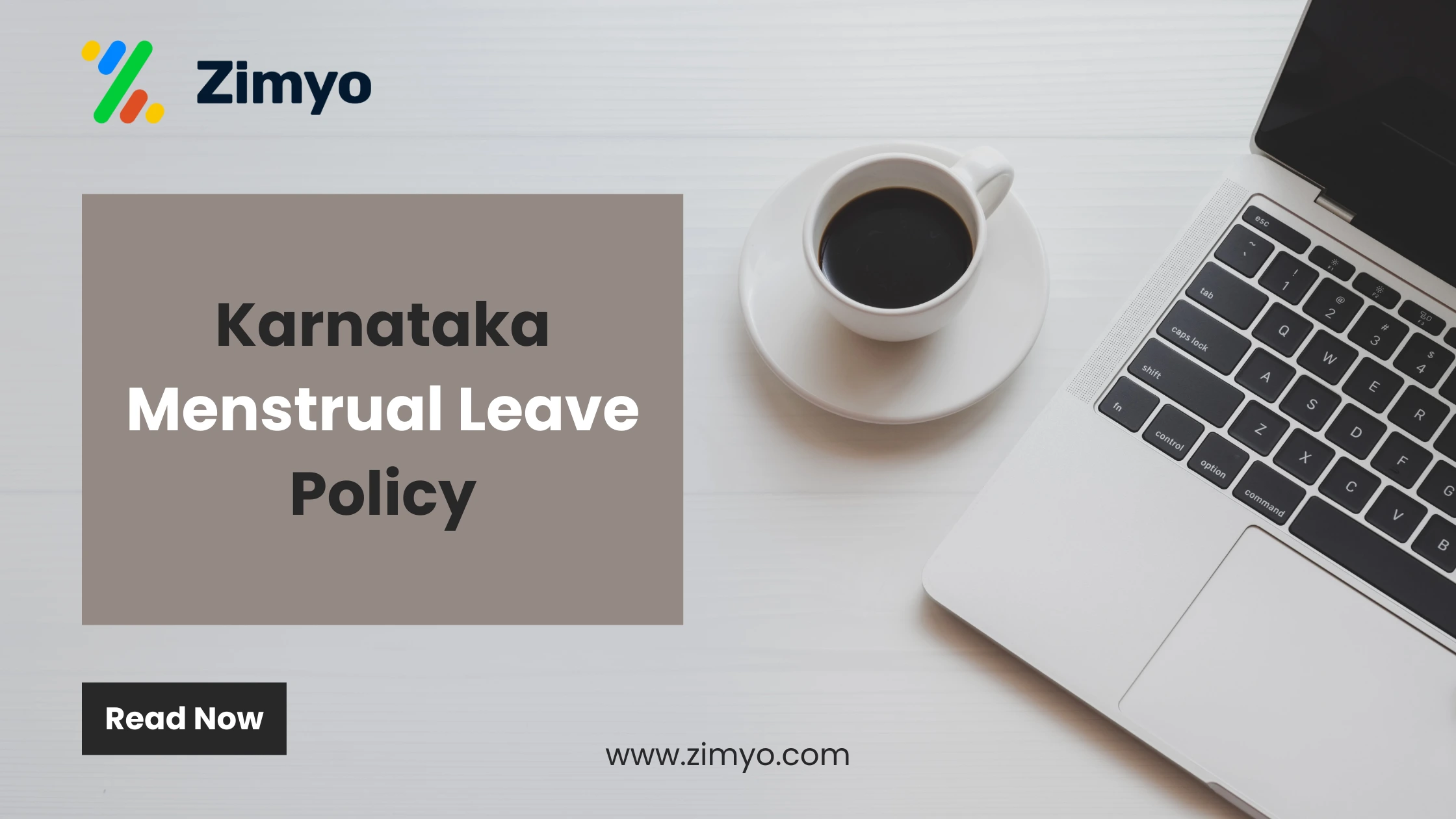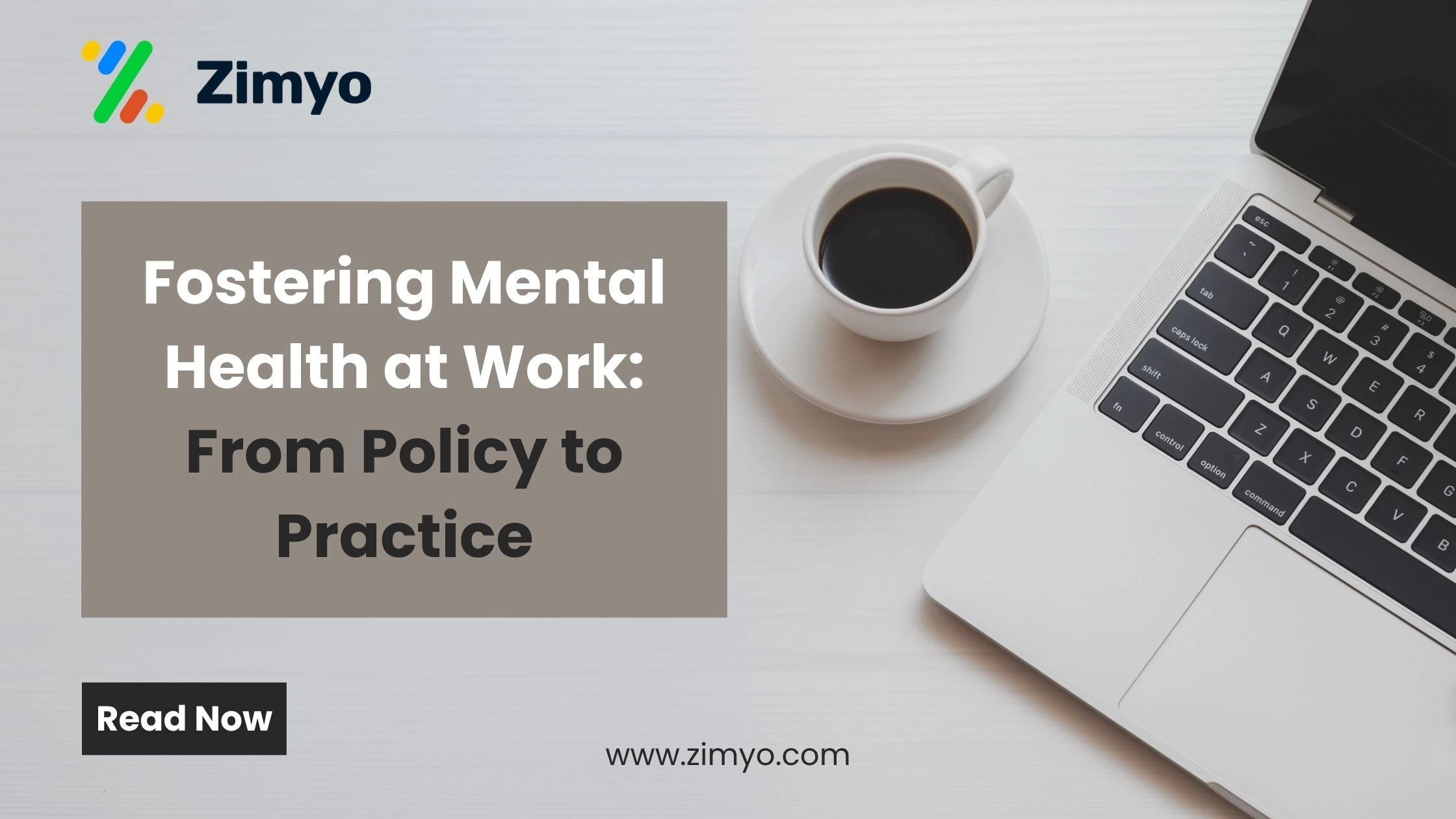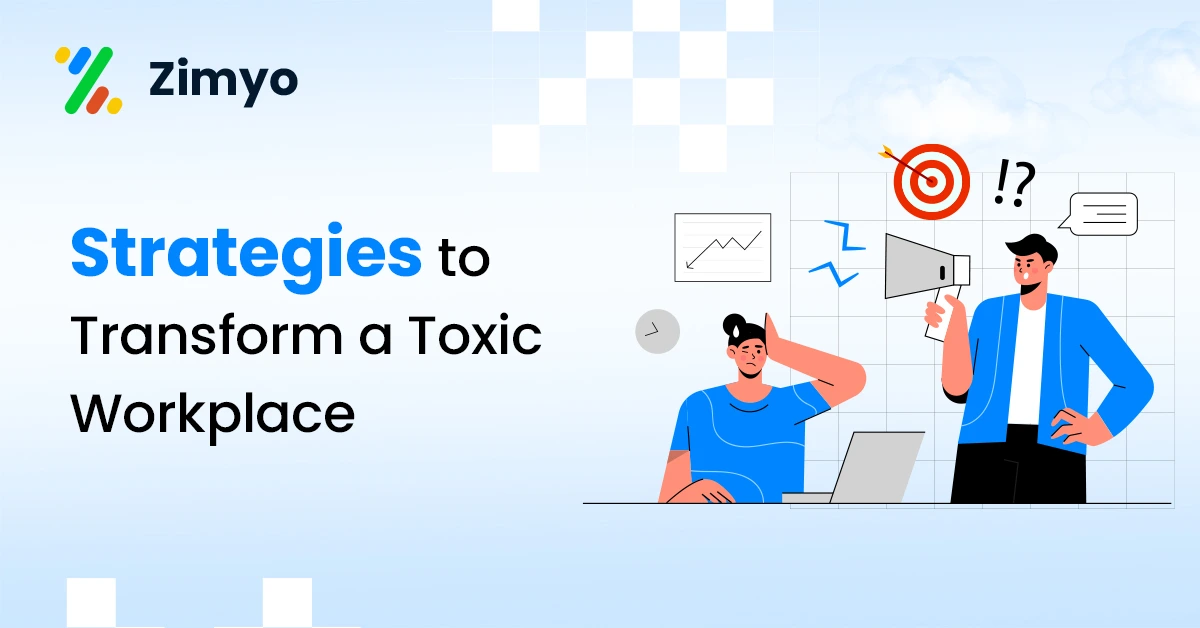Each organization is founded on the robustness of its people. When employees are safe, valued, and supported, they are likely to give their best contribution. That is where employee welfare comes in as a key aspect. Beyond wages and mandatory benefits, employee welfare encompasses creating an environment where individuals can flourish physically, mentally, socially, and financially.
In today’s highly competitive business landscape, companies with welfare priorities are employer-of-choice organizations. From formal employee welfare policies to well-structured welfare programs, organizations can cultivate a healthier, happier, and more productive workforce. Therefore, this article discusses the definition of employee welfare, its characteristics, various types, advantages, examples of successful policies, and how to establish a welfare system that adheres to contemporary HR practices.
Employee Welfare Meaning: What Does It Include?
The employee welfare meaning in HRM is the sum of services, facilities, and programs that contribute to employees’ overall welfare. While compensation is mostly monetary, welfare reaches out to factors such as health, safety, mental well-being, work-life balance, and career growth.
Welfare in employee welfare in HRM from an HRM viewpoint is categorized under a wide rubric that includes:
- Statutory welfare: Mandatory and legal provisions such as safety appliances, provident fund, medical leave, and maternity/paternity leave benefits.
- Voluntary welfare: Provision made by employers in addition to the mandatory provisions, including flexible working hours, training schemes, employee counseling, and monetary help.
- Intra-mural welfare: Facilities given within the factory, including clean drinking water, lavatories, mess, or recreation rooms.
- Extra-mural welfare: Welfare benefits extended outside the organization, such as housing accommodations, transport, childcare, and grants for children of employees.
Employee welfare, therefore, encompasses anything from minimum essentials in the workplace to extensive programs for enhancing quality of life among employees and their families.
Key Features of Employee Welfare Programs
A good employee welfare program is not merely a matter of adding benefits or meeting legal obligations; it’s creating a sustainable care system that enriches employees’ professional and personal experiences. To understand this better, listed below are the key characteristics of employee welfare in HRM which make programs effective and lasting:
1. Comprehensive Coverage
The primary characteristic of an effective welfare program is broad-based coverage. In other words, welfare must touch on employees’ overall well-being ranging from physical and financial to mental and emotional. For example, while medical needs may be addressed through health insurance, programs such as counseling services, flexible work schedules, and financial planning sessions ensure that other dimensions of employee welfare are not overlooked.
As a result, in-depth coverage makes workers feel cared for in every aspect of their life, not only in their workplace.
2. Employee-Centric Design
Each workplace is different, and so are the employees. Therefore, an effective welfare program needs to be employee-centric, guided by real needs and feedback, not assumptions. HR teams can carry out surveys, feedback meetings, or even town halls to know what workers care about the most.
For example, younger workers might demand learning and career development opportunities, whereas parents might expect childcare assistance and flexible work arrangements. By tailoring welfare services to meet such diverse needs, organizations can foster greater commitment and loyalty among their workforce.
3. Accessibility and Inclusivity
A welfare program works only if it’s made available to all. This means employees across job levels, gender, departments, and locations should be able to enjoy the benefits without any redundant limitations. For instance, providing health insurance to permanent employees but not contract workers may foster feelings of injustice.
Additionally, inclusivity requires addressing the needs of disabled employees, individuals from diverse socio-economic backgrounds, and off-site staff. Ultimately, the goal is to build a welfare system that includes everyone, which in turn fosters trust and a strong culture of fairness.
4. Legal Compliance
One of the essential characteristics of employee welfare in HRM is adherence to statutory legislation. Employers have to see to it that their welfare schemes are at par with legal requirements like work place safety guidelines, maternity benefits, minimum wages, working conditions, and retirement scheme contributions.
Non-compliance is punishable, triggers lawsuits, or undermines reputation. Conversely, where welfare practices are in harmony with labor laws, workers are safe in the knowledge that their fundamental rights are being safeguarded.
5. Flexibility and Adaptability
The modern workplace is changing very fast – with remote work, hybrid arrangements, and gig economy becoming the new norms. Welfare schemes must therefore be adaptable and flexible.
For instance, in place of inflexible benefits, organizations can provide a “cafeteria plan” through which workers select the benefits that are most applicable to them, whether it is a healthcare plan, childcare benefit, or skills upgrading assistance. Flexibility ensures the welfare programmes are still applicable as the workforce demographics and needs evolve in the long term.
6. Transparency and Communication
Even the most excellent welfare measures are defeated when employees do not know about them. Open communication is a characteristic of effective employee welfare programs. Employees should be aware of:
- What benefits are included
- Who are included
- How to claim or apply
- Timelines for approval
Clear communication is possible through well-written employee welfare policies, HR portals, and frequent awareness campaigns. With the benefits explained lucidly and made easily accessible, the employee is likely to trust and avail them.
7. Preventive Focus
Good welfare is not merely reactive (treating problems after they arise); it is preventive. Organizations must have a focus on initiatives that prevent problems such as stress, accidents, and financial crises from arising at all.
Examples are:
- Routine medical check-ups and immunization campaigns
- Stress management workshops
- Overdraft facilities for sudden financial difficulties
- Ergonomic office layouts to avoid long-term injuries
Through prevention, companies incur lower costs and employees have a healthier, stress-free work environment.
8. Employee Engagement and Participation
Welfare schemes are more effective where employees participate in them. Getting employees to help develop, promote, and enhance welfare schemes guarantees increased take-up. A good example is establishing employee welfare committees, which provide employees with a voice when initiatives are made, whereas gamification wellness challenges (such as step-competition challenges) motivate individuals to participate.
Participation transforms welfare from an HR monologue to a partnership.
9. Sustainability
A welfare program must be operationally and financially sustainable. Organizations tend to initiate programs with zeal but find it hard to sustain them as they are subject to budget restrictions or inadequate support from management.
Sustainability is developing welfare initiatives that are scalable with the business. For example, digital wellness and wellness platforms are scalable and easily reach a workforce of 100 or 10,000 employees. Financial prudence and long-term planning provide assurance to employees that they will have welfare on a consistent basis.
10. Measurable Outcomes
The last characteristic of a robust welfare program is that it has the capability to yield measurable results. Welfare needs not be considered a “feel-good” effort only, it needs to demonstrate results in terms of:
- Decreased absenteeism
- Enhanced employee engagement scores
- Decreased turnover rates
- Increased productivity levels
- Employee feedback in a positive sense
Through HR technology, organizations can monitor these metrics and continually optimize welfare programs. Quantifiable results rationalize the investment and demonstrate that welfare benefits employees as well as the company.
Types of Employee Welfare
The two primary categories of employee welfare are:

1. Statutory Welfare
They are welfare provisions mandated by law, and organizations have to offer them to employees.
Examples: safety measures at the workplace, minimum wages, maternity leave benefits, canteen facilities, drinking water facility, toilets, first-aid, equal pay for equal work, regulation of working hours.
2. Non-Statutory Welfare
They are voluntary efforts offered by employers to enhance employee satisfaction, motivation, and productivity.
Examples: wellness programs, flexible work schedules, employee assistance programs (EAP), transport facilities, recreation activities, training and development, subsidized meals, career development opportunities.
Different Types of Employee Welfare Activities
Companies implement a range of welfare activities based on their sector, employee population, and finance. The various employee welfare activities are:
1. Health and Safety Welfare
- Periodic health check-ups
- Ergonomic office layout
- Safety training and protective equipment
- Compulsory insurance against accidents and sicknesses
2. Economic Welfare
- Provident fund and pension plans
- Interest-free staff loans
- Housing allowances and transport facilities
- Performance bonus
3. Recreational and Social Welfare
- Sports events sponsored by the company
- Team outings, cultural events, and festive celebrations
- Gym membership or recreational club membership
4. Educational and Development Welfare
- Scholarships for children of employees
- Reimbursement of tuition fees for higher education
- Training and development workshops in-house
5. Work-Life Balance Welfare
- Flexible work hours
- Home or hybrid work arrangement
- Parental leave and childcare provision
6. Counseling and Mental Health Support
- Stress management programs
- Confidential counseling services
By expanding welfare activities, businesses are able to address the multi-faceted needs of staff and support general well-being.
Major Benefits of Employee Welfare for Organizations and Employees
Spending on employee welfare benefits returns dividends to both workers and managers.
For Employees:
- Improved physical and mental well-being
- Greater security for finances
- Improved work-life balance
- Improved job satisfaction and motivation
- Access to opportunities for personal and professional development
For Organizations:
- Increased Productivity: Healthy and satisfied employees produce higher-quality work.
- Reduced Attrition: Effective welfare programs enhance retention and lower recruitment expenses.
- Enhanced Morale: Workers feel appreciated and form a greater emotional bond with the company.
- Strong Employer Brand: Companies recognized for welfare draw the best employees with ease.
- Less Absenteeism: With measures of prevention of health and wellness support systems, absenteeism and burnout are reduced.
Essentially, welfare creates a workplace environment in which employees are valued and empowered, and this will directly lead to business success.
Essential Elements of a Strong Employee Welfare Program
Whereas features tell us what welfare programs are like, essential elements tell us how to construct and operate them successfully. These are the blocks on which effective employee welfare in HRM is constructed as follows:
- Needs Assessment – Identify gaps through surveys, exit interviews, and performance data.
- Transparent Objectives – Establish quantifiable objectives such as decreasing attrition by 10% or enhancing wellness participation levels.
- Strong Employee Welfare Policies – Develop formal policy documents for eligibility, benefits, and procedures.
- Leadership Commitment – Direct management participation to support and initiate welfare programs.
- Budget Allocation – Sufficient financial provision guarantees welfare program sustainability.
- Diverse Program Mix – Incorporate health, financial, recreational, education, and social welfare activities.
- Technology Integration – Leverage HRMS tools for automating processes, monitoring usage of benefits, and maintaining compliance.
- Communication & Awareness – Deploy campaigns, FAQs, and training to make welfare services known to employees.
- Training for Managers – Managers need to be trained to mentor staff towards welfare resources.
- Feedback & Evaluation Mechanism – Gather continuous feedback and utilize analytics to improve programs.
Composed together, these factors make sure that employee welfare schemes are well-organized, effective, and well-respected by the employees.
Examples of Effective Employee Welfare Policies
Goodly written policies give clarity and consistency. The following are some employee welfare examples:
- Health & Wellness Policy: Provides medical benefits, fitness reimbursement, and mental wellness support.
- Parental Support Policy: Maternity and paternity leave pay, adoption leave, and childcare facilities.
- Flexible Work Policy: Permits hybrid working, remote work, and flexible working hours.
- Education Aid Policy: Reimbursement for post-secondary education, certification training, and scholarships.
- Recreation & Team Building Policy: Outings sponsored by the company, wellness camps, and sports clubs.
- Emergency Assistance Policy: Interest-free loan or grant for unexpected financial emergencies.
- Recognition Policy: Formal rewards and appreciation schemes to encourage employees.
These employee welfare policies are real-life examples that can be tailored to the needs of an organization’s workforce.
Steps to Build an Employee Welfare System in the Workplace
Here are the steps that you can follow:
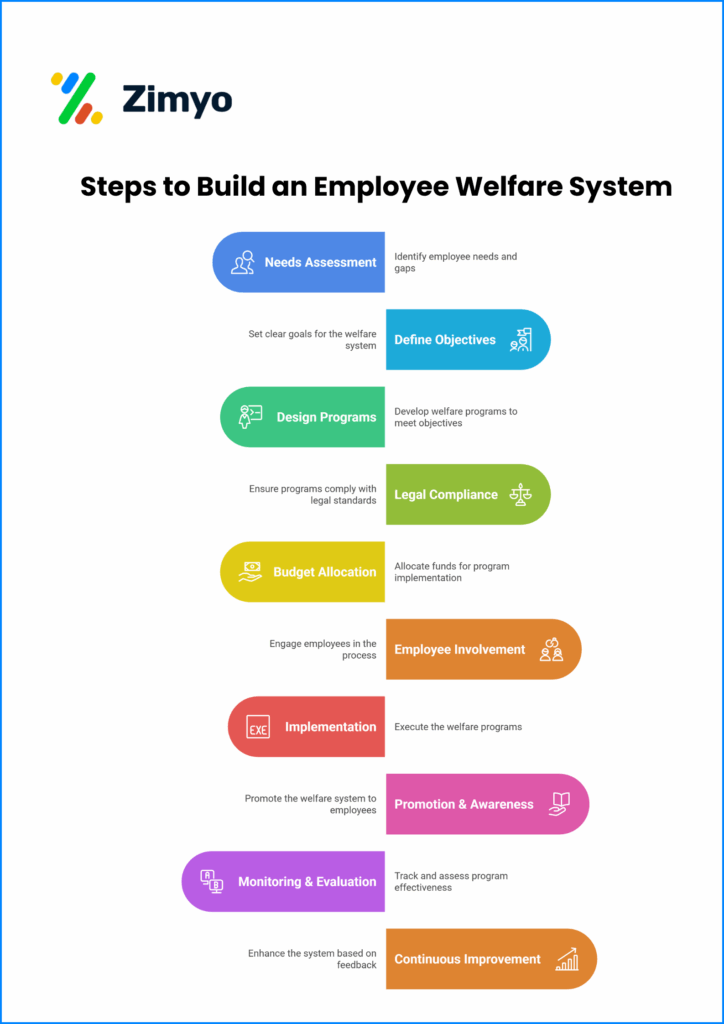
1. Conduct a Comprehensive Needs Assessment
- Survey staff to determine welfare needs.
- Audit current staff welfare policy and benchmark industry best practice.
- Examine employee demographics, job functions, and workplace issues.
2. Set Clear Objectives for the Welfare System
- Establish goals (health, safety, well-being, financial security, work-life balance).
- Align objectives with organisational culture and HR strategy.
- Establish measurable KPIs to monitor effectiveness.
3. Design Tailored Employee Welfare Programs
- Develop varied programs that address statutory and non-statutory welfare.
- Make provision for physical health, mental well-being, social interactions, and financial assistance.
- Tailor welfare arrangements to various groups of employees (e.g., frontline workers vs. corporate employees).
4. Ensure Compliance with Legal and Statutory Requirements
- Comply with labor legislation, safety standards, and equal pay policies.
- Integrate employee welfare into HRM practices that are compatible with government standards.
- Regularly review compliance to prevent legal exposures.
5. Allocate Budget and Resources
- Make financial provisions for activities for staff welfare.
- Assign the implementation to HR, managers, or welfare officers.
- Make long-term sustainability possible through cost-effective plans.
6. Engage Employees in the Planning Process
- Establish welfare committees or focus groups for feedback.
- Promote suggestions and decision-making involvement.
- Create ownership and trust by involving employees in the process.
7. Implement Welfare Initiatives Effectively
- Roll out programs gradually via pilot programs.
- Train HR and managers in the delivery of welfare programs.
- Make available convenient channels for the use of benefits by employees.
8. Promote Awareness and Accessibility
- Clearly communicate welfare policies to all employees.
- Utilize internal newsletters, HRMS, workshops, and noticeboards to increase visibility.
- Inculcate inclusivity by facilitating easy accessibility of welfare measures for all.
9. Monitor, Measure, and Evaluate Success
- Monitor rates of participation and levels of employee satisfaction.
- Gather periodic feedback via surveys and individual meetings.
- Utilize HR analytics to measure productivity, retention, and engagement effects.
10. Make Continuous Improvements
- Tailor welfare initiatives to changing employee expectations.
- Refine policies according to workplace trends (hybrid culture, remote work, mental health).
- Innovate using technology such as HRMS solutions for automating welfare management.
How Zimyo Enhances Employee Welfare Initiatives
Technology assistance is required for modern welfare management. Zimyo assists organizations in designing, executing, and tracking employee welfare programs effectively:
- Centralized Platform: Consolidate all welfare policies and benefits under one umbrella.
- Employee Self-Service: Employee welfare benefits, loans, and reimbursement applications directly from the app.
- Automated Approvals: Streamlines claims and lightens HR’s administrative burden.
- Payroll Integration: Makes welfare benefits such as allowances and reimbursements accurately updated in salaries.
- Analytics & Reporting: Offers insights into welfare usage, employee satisfaction, and ROI on programs.
- Wellbeing Programs: Facilitates HR to initiate and monitor health, fitness, and engagement activities.
- Compliance Management: Ensures that all welfare programs are compliant with statute.
By simplifying complexity and promoting transparency, Zimyo enables HR to concentrate on employee care rather than administrative woes.
Conclusion
Employee welfare is not compliance; it’s about building a culture where employees are looked after, appreciated, and encouraged. From statutory to voluntary schemes, welfare permeates every facet of an employee’s existence – health, money, social welfare, and career development.
Consequently, companies that have robust employee welfare policies and programs enjoy long-term dividends: decreased attrition, improved productivity, and increased employee loyalty. Moreover, by using the right tools, like Zimyo, companies can take their welfare initiatives to the next level, creating workplaces where employees can actually flourish.
FAQs
What is employee welfare in HRM?
Employee welfare in HRM refers to the measures, policies, and services provided by an organization to ensure employees’ well-being, covering health, safety, financial security, and work-life balance.
How many types are employee welfare?
There are mainly two types of employee welfare: statutory welfare (mandated by law, such as safety measures) and non-statutory welfare (voluntary initiatives like wellness programs, training, and recreational facilities).
What is an employee welfare plan?
An employee welfare plan is a structured framework of benefits, policies, and activities designed to improve employees’ physical, mental, and social well-being while enhancing job satisfaction and productivity.
What are the principles of employee welfare?
The principles include social justice, adequacy of benefits, democratic involvement, adaptation to employee needs, and alignment with organizational goals, ensuring fair and inclusive welfare practices.
What is the role of HR in employee welfare?
HR plays a vital role by designing welfare policies, ensuring legal compliance, implementing welfare programs, monitoring effectiveness, and fostering a supportive work culture.

